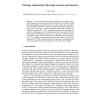Free Online Productivity Tools
i2Speak
i2Symbol
i2OCR
iTex2Img
iWeb2Print
iWeb2Shot
i2Type
iPdf2Split
iPdf2Merge
i2Bopomofo
i2Arabic
i2Style
i2Image
i2PDF
iLatex2Rtf
Sci2ools
EKAW
2010
Springer
2010
Springer
Ontology Engineering with Rough Concepts and Instances
A scenario in ontology development and its use is hypothesis testing, such as finding new subconcepts based on the data linked to the ontology. During such experimentation, knowledge tends to be vague and the associated data is often incomplete, which OWL ontologies normally do not consider explicitly. To fill this gap, we use OWL 2 and their application infrastructures together with rough sets. Although OWL 2 QL is insufficient to represent most of rough set’s semantics, the mapping layer of its Ontology-Based Data Access framework that links concepts in the ontology to queries over the data source suffice to ascertain if a concept is rough, which subsequently can be modelled more precisely in an OWL 2 DL ontology. We summarise the trade-offs and validate it with the HGT ontology and its 17GB genomics database and with sepsis, which demonstrates it is an encouraging step toward comprehensive and usable rough ontologies.
| Added | 25 Jan 2011 |
| Updated | 25 Jan 2011 |
| Type | Journal |
| Year | 2010 |
| Where | EKAW |
| Authors | C. Maria Keet |
Comments (0)

